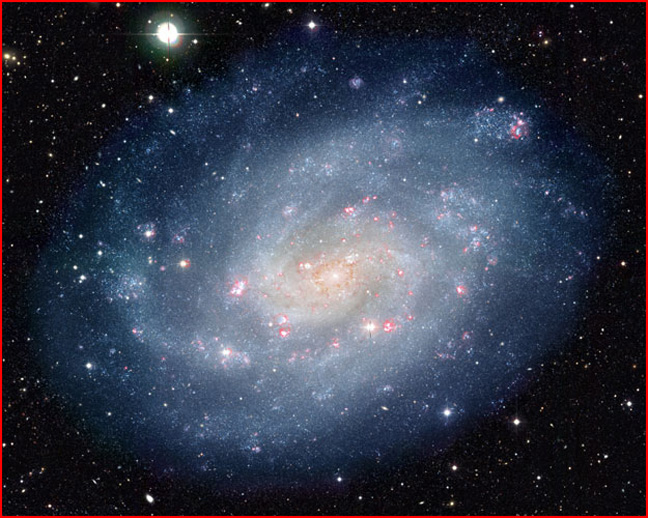|
|
||
 Credit: M. Schirmer (IAEF, Bonn), W. Gieren (Univ. de Concepción, Chile), et al., ESO |
||
|
pic of the day Links:
Society for
|
Nov 08, 2004 This galaxy, NGC 300, is an offspring of the Milky Way. It is the largest galaxy in the Sculptor Group of galaxies, all of which are descendants of the Milky Way. This group is the next-nearest cluster of galaxies to the Local Group, of which the Milky Way is a member. You can see it with a small telescope in the constellation Sculptor. On galactic star maps, you can see that the cluster is aligned with the south pole of our Milky Way galaxy. The Sculptor Group is also the center of a large cluster of quasars. These quasars are the offspring of several galaxies in the Group and therefore grandchildren of the Milky Way. Within this cluster of quasars, two denser accumulations stand out. The largest is a long stream (almost 20 times the length of the full moon) that points directly at the center of NGC 300 along its spin axis. The second group of quasars is clustered around the second-largest galaxy of the Sculptor Group, NGC 55. In order to "see" the Milky Way as a grandparent galaxy and NGC 300 as a parent, we must first unlearn a basic belief of 20th century astronomy -- that we know how to measure galactic distances with the simple formula that redshift equals distance. Because of that belief, all of the quasars in this group are considered background objects and it is only coincidence that they line up along the spin axes of NGC 300 and the Milky Way. From an electric universe point of view, polar alignments are exactly what is expected. These alignments are seen at all observable scales. We find the same characteristic in laboratory experiments and in the data returned by space probes exploring the solar system. It is found on the Sun, in planetary nebulae, and in stars. The next scale up is galaxies. If we can look past the distortion of our belief that galactic distances are known, then the polar streamers are clearly seen. Galaxies have a whole new meaning. They come in families. They are born. Their redshift changes as they mature. What exciting new prospects for 21st century astronomy!
|
|
|
Copyright 2004: thunderbolts.info |
||
